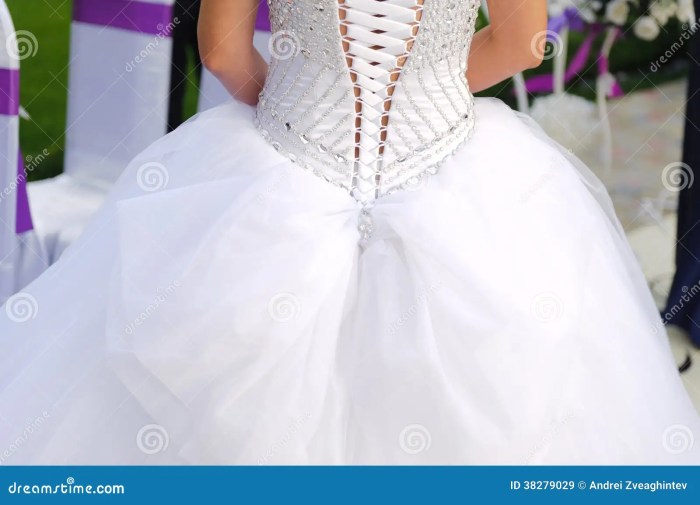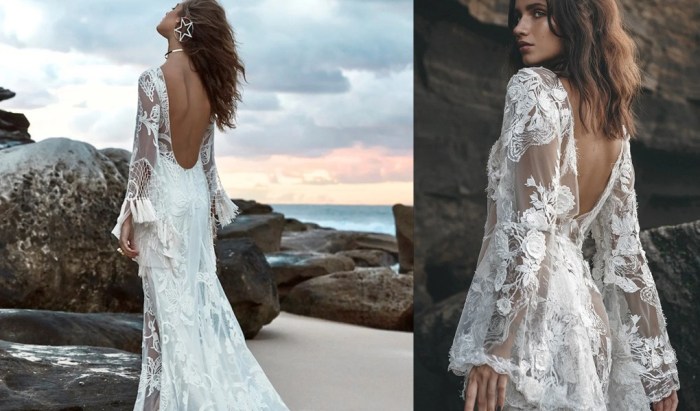A History of Buttons on the Back of Wedding Dresses: Buttons On Back Of Wedding Dress
Buttons on back of wedding dress – The humble button, often overlooked, plays a surprisingly significant role in the history and aesthetics of wedding dresses. From subtle functional closures to elaborate decorative elements, buttons on the back of a gown tell a story of evolving design, cultural influences, and evolving fashion trends. This exploration delves into the fascinating journey of back buttons in bridal wear, from their historical context to their contemporary interpretations.
Historical Context of Back Buttons on Wedding Dresses
The use of buttons on wedding dresses has evolved significantly throughout history, reflecting the changing social norms and technological advancements of each era. Early examples, dating back to the Victorian era, often featured simple, functional buttons primarily used to fasten the back of the gown. These buttons were frequently made of materials such as mother-of-pearl or bone, reflecting the available resources and craftsmanship of the time.
The cultural significance varied; in some cultures, the act of buttoning the dress might have symbolized the joining of two families or the commitment of the couple. As the 20th century progressed, button details became more decorative, often incorporating embellishments like crystals or pearls, reflecting a shift towards greater emphasis on ornamentation and visual appeal.
Comparing different cultures reveals interesting contrasts. While Western wedding dresses often incorporated buttons as a practical and decorative element, some Eastern cultures may have employed different fastening methods altogether, or used buttons with unique symbolic meanings.
Design Aspects and Functionality of Back Buttons

Source: dreamstime.com
The design and functionality of back buttons on wedding dresses are highly diverse. The choice of button material, size, and placement significantly impacts the overall aesthetic of the gown. Attachment methods also vary, impacting both the look and durability of the garment.
| Button Type | Attachment Method | Pros | Cons |
|---|---|---|---|
| Fabric-covered | Hand-sewn | Seamless blend with fabric, elegant look, durable | Time-consuming to sew, potentially more expensive |
| Pearl | Machine-sewn | Classic, elegant, relatively easy to replace | Can be less durable than hand-sewn buttons, may scratch |
| Crystal | Hand-sewn | Adds sparkle and glamour, visually striking | Can be fragile, expensive, requires careful handling |
| Metal | Machine-sewn | Durable, variety of finishes available | Can feel less luxurious than other materials |
Aesthetic Impact and Styling Considerations, Buttons on back of wedding dress

Source: inweddingdress.com
Back buttons significantly influence a wedding dress’s overall aesthetic. They can add a touch of classic elegance, a modern twist, or a touch of romantic charm, depending on the style and placement. The buttons themselves can create a vertical line that elongates the silhouette, especially on gowns with a fitted bodice.
- Necklines like bateau, V-neck, or sweetheart necklines often pair well with back button details.
- Back styles such as a low back, illusion back, or even a more traditional high neckline can all be enhanced by thoughtfully chosen buttons.
- Consider the overall theme and style of the wedding when choosing buttons; minimalist designs may call for understated buttons, while more elaborate gowns can handle bolder choices.
- Avoid buttons that clash with the overall color palette or fabric of the dress.
Practical Implications and Maintenance
Proper care and maintenance are crucial for preserving a wedding dress with back buttons. Regular cleaning and careful handling will help extend the life of the garment and maintain its pristine appearance.
Fastening and unfastening the buttons should be done gently to prevent damage. If a button becomes loose or falls off, it’s essential to have it repaired by a professional seamstress to avoid further damage.
- Potential issues include broken or loose buttons, snagged threads, and fabric wear around the buttonholes.
- Regular professional cleaning and storage in a protective garment bag are recommended.
- For minor repairs, a needle and thread that matches the dress fabric can be used.
Modern Interpretations and Trends
Contemporary wedding dress designers continue to showcase innovative and stylish uses of back buttons. The trend often incorporates unique button placements, materials, and arrangements, resulting in both classic and contemporary designs.
- Many designers are incorporating unexpected materials, such as wood or resin, into their button designs.
- Some designers create unique patterns with the buttons, while others use them to highlight specific design elements of the gown.
- Designers like [Designer Name 1], [Designer Name 2], and [Designer Name 3] are known for their distinctive use of buttons in their bridal collections.
Illustrative Examples of Back Button Designs
Let’s examine three distinct examples of back button designs to highlight the versatility of this detail.
Example 1: A classic A-line gown in ivory silk crepe features a row of small, pearly buttons extending from the waist to the neckline. The subtle elegance of the buttons complements the simplicity of the dress, creating a timeless look. The buttons are evenly spaced, creating a clean vertical line that accentuates the back’s shape. In soft, diffused lighting, the pearls softly glow, while under bright light, their luminosity is more pronounced.
Example 2: A modern sheath dress in blush pink silk features a cascading arrangement of larger, crystal buttons. The buttons are strategically placed, following the curve of the back, creating a visually striking effect. The crystal buttons catch the light, adding a touch of sparkle and glamour. The effect is amplified under brighter lighting conditions.
Example 3: A bohemian-inspired gown in lace features fabric-covered buttons in a mismatched arrangement. The unique placement of the buttons and their slightly different sizes add a touch of whimsy and unconventionality. The effect is softer and more understated, particularly in low light conditions, with the texture of the lace and fabric buttons playing a larger role.
The buttons on the back of a wedding dress often present a charming detail, adding a touch of elegance to the overall design. However, if you find the back detailing too simple or want extra warmth, consider adding a layer with a beautiful bridal jacket, perhaps finding inspiration from the wide selection available at bridal jackets for wedding dress.
The buttons on the back then become a complementary element, rather than the sole focus.
Top FAQs
How do I clean buttons on my wedding dress?
Spot clean delicate buttons with a damp cloth and mild detergent. For more robust buttons, consult a professional dry cleaner.
What if a button falls off my wedding dress?
Carry a spare button and a needle and thread for quick repairs. Alternatively, contact a seamstress for professional assistance.
Are all wedding dress buttons the same quality?
No, button quality varies greatly. Higher-end dresses often use more durable and aesthetically pleasing buttons.
How do I choose the right buttons for my dress?
Consider the overall style of your dress and choose buttons that complement the fabric, embellishments, and overall aesthetic.
